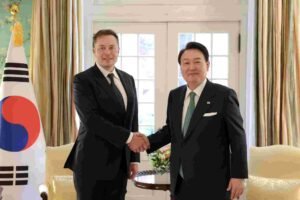In a strategic move, SpaceX successfully launched South Korea’s inaugural spy satellite from California’s Vandenberg Space Force Base, marking a significant development in the geopolitical landscape of the Korean peninsula. The launch follows North Korea’s recent triumph in placing its military reconnaissance satellite into orbit just a month prior.
South Korea’s Secrecy
On Friday, a SpaceX Falcon 9 rocket carried the South Korean spy satellite into space, underlining the growing reliance of nations on commercial space entities for their satellite deployment needs. However, SpaceX chose to conclude its live coverage of the mission shortly after liftoff, leaving the deployment of the South Korean payload shrouded in secrecy. The decision not to broadcast the satellite’s deployment hints at the sensitive nature of the mission, considering the satellite’s primary role in bolstering South Korea’s surveillance capabilities.
Collaboration Between South Korea and SpaceX
This mission is part of a broader collaboration between South Korea and SpaceX, as the Asian nation aims to deploy a total of five spy satellites by 2025. This partnership stems from South Korea’s push to establish a 24-hour watch over the Korean peninsula, emphasizing the significance of space-based intelligence in maintaining regional security.
Notably, South Korea had achieved a milestone in May by utilizing its domestically produced Nuri launch vehicle to place a mission-capable satellite into orbit for the first time. However, the subsequent collaboration with SpaceX highlights the nation’s intent to expedite its satellite deployment goals, leveraging the expertise and proven track record of the American aerospace manufacturer.
North Korea: The challenge for South Korea
The backdrop of this space race is amplified by North Korea’s recent success in deploying its Malligyong-1 reconnaissance satellite using its Chollima-1 launch vehicle. Despite the achievement, North Korea has yet to release any imagery captured by the satellite, leaving analysts in the dark about its full capabilities. The secrecy surrounding the North Korean satellite raises questions about the true extent of its reconnaissance capabilities and adds an element of uncertainty to the regional security dynamics.
The space endeavors of both Koreas underscore the evolving role of space technology in national security strategies. As nations invest in satellite capabilities, the ability to monitor and gather intelligence becomes a crucial aspect of modern defense. The juxtaposition of South Korea’s collaboration with SpaceX and North Korea’s independent satellite launch showcases the divergent approaches these nations are taking in space exploration and security.
While South Korea embraces international partnerships to enhance its space capabilities, North Korea pursues an autonomous path, reflecting its desire for self-reliance and independence in space endeavors. The contrasting strategies highlight the broader geopolitical context and power dynamics at play in the Korean peninsula.
As South Korea continues to strengthen its space program through collaborations with industry leaders like SpaceX, the nation inches closer to achieving its goal of constant surveillance over the Korean peninsula. The deployment of spy satellites contributes not only to national security but also to the overall stability of the region by providing timely and accurate intelligence.
New Dimension To Space race
The recent SpaceX launch of South Korea’s first spy satellite adds a new dimension to the ongoing space race in the Korean peninsula. The collaboration between South Korea and SpaceX signifies a strategic alignment to harness the expertise of the private space sector for national security objectives. As the two Koreas pursue divergent paths in space exploration, the implications for regional stability and security remain at the forefront of this evolving narrative. The successful deployment of South Korea’s spy satellite marks a pivotal moment in the nation’s pursuit of advanced space capabilities and underscores the intricate balance of power in the dynamic East Asian region.












Comments 1